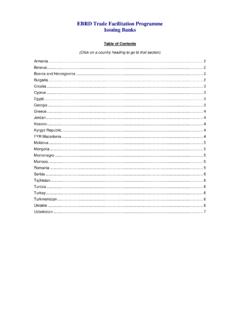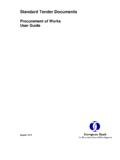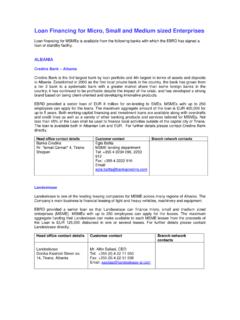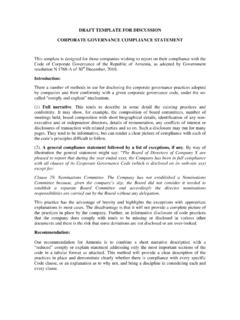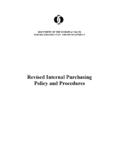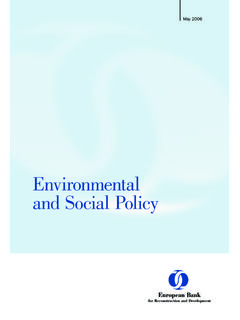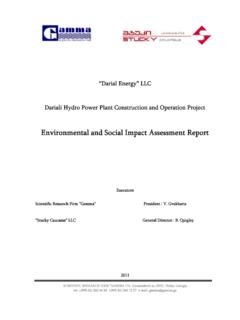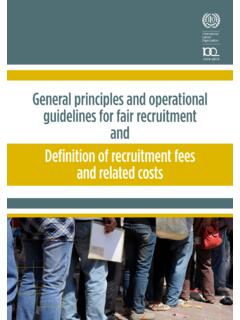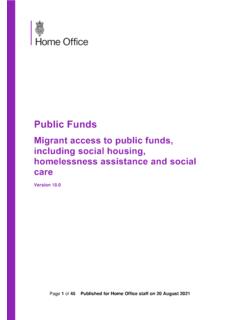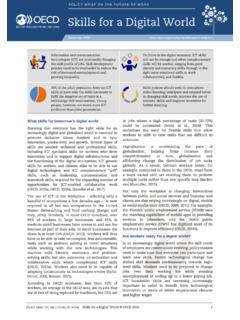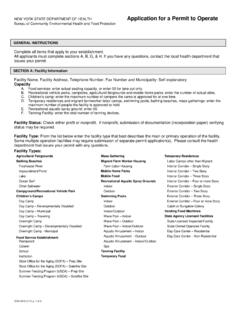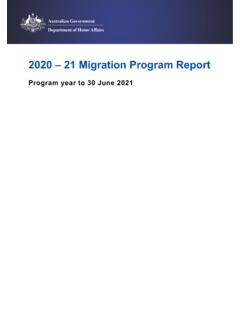Transcription of Workers’ accommodation: processes and standards
1 Workers accommodation: processes and standardsA guidance note by IFC and the EBRDIFC/EBRD | Guidance on Workers Accommodation The EBRD is an international financial institution that supports projects from central Europe to central Asia. Investing primarily in private sector clients whose needs cannot be fully met by the market, we foster transition towards open and democratic market economies. In all our operations we follow the highest standards of corporate governance and sustainable development.
2 IFC, a member of the World Bank Group, creates opportunity for people to escape poverty and improve their lives. We foster sustainable economic growth in developing countries by supporting private sector development, mobilising private capital, and providing advisory and risk mitigation services to businesses and governments. Our new investments totalled US$ 15 billion in fiscal 2009, helping play a prominent role in addressing the financial crisis. For more information, visit About this guidance noteThis Guidance Note is aimed at providing practical guidance to IFC and EBRD specialists, consultants and clients on the processes and standards that should be applied to the provision of workers accommodation in relation to projects funded by IFC or the EBRD.
3 Applying appropriate standards to the construction and operation of worker housing falls within the performance requirements on labour and working conditions expected of clients by both institutions. The Guidance Note also provides examples of good practice approaches that businesses have successfully applied in their operations. IFC and the EBRD have not financed all the projects or companies mentioned in the Note. Some of the information in the Note originates from publicly available sources such as company web sites.
4 IFC and the EBRD have not verified the accuracy of such information nor the companies practices. This Guidance Note is not intended to establish policy itself; and any issues arising in an IFC- or EBRD-financed project will be assessed and addressed in the context of the particular circumstances of that project. The EBRD and IFC recognise that there are no comprehensive international regulations relating to workers accommodation, and that good and best practices are constantly evolving. The EBRD and IFC intend to update this Guidance Note to reflect such developments, and would welcome feedback and comments from users to contribute to this process.
5 Comments should be sent to and ContentsEXECUTIVE SUMMARY1 INTRODUCTION2 PART I: PLANNING AND ASSESSING REQUIREMENTS FOR WORKERS ACCOMMODATION4I. Assessing the need for workers accommodation5A. Availability of workforce5B. Availability of existing housing5II. Assessing impacts of workers accommodation on communities6A. Specific impacts during the construction phase7B. Community infrastructure7C. Community services and facilities7D. Local businesses and local employment7E. Community health and safety7F.
6 Community cohesion7G. Land acquisition and resettlement7H. Dismantling and reinstatement7 III. Types of workers accommodation9 PART II: standards FOR AND MANAGEMENT OF WORKERS ACCOMMODATION11I. standards for workers accommodation 11A. National/local standards11B. General living facilities11C. Room/dormitory facilities13D. Sanitary and toilet facilities14E. Canteen, cooking and laundry facilities14F. standards for nutrition and food safety16G. Medical facilities17H. Leisure, social and telecommunication facilities18II.
7 Managing workers accommodation18A. Management and staff18B. Charging fees for accommodation and services19C. Health and safety on site19D. Security of workers accommodation20E. Workers rights, rules and regulations on workers accommodation21F. Consultation and grievance mechanisms22G. Management of community relations22 ANNEX I: CHECKLIST ON WORKERS ACCOMMODATION24 August 20091 Workers accommodation: processes and standardsPublic guidance note by IFC and the EBRDEXECUTIVE SUMMARYThis guidance note addresses the processes and standards that should be applied to the provision of workers accommodation in relation to projects funded by the EBRD or IFC.
8 Applying appropriate standards to the construction and operation of worker housing falls within the performance requirements on labour issues expected of clients by both is a range of different types of workers accommodation that may be required by various projects and at different stages within projects, including temporary exploration camps, construction camps and permanent dormitories. Specific issues arise in relation to each of these. This note reviews various international, national, private sector and public sector standards and guidance that are more generally applicable.
9 In some cases clear standards or good practice have been identified. In others, we present a range of standards that provide some flexibility and adaptability within the local context. In these cases, compliance with at least the minimum standard is for consideration are organised in terms of a staged process to be undertaken in planning, constructing and then operating worker housing facilities. These issues may be relevant to the direct client or to (sub)contractors undertaking particular elements of a project, such as construction or management of facilities.
10 In cases where contractors are used, it is important to set up appropriate mechanisms and processes (reporting/monitoring) to ensure that performance requirements are complied the initial stage of any project, there is a need to assess whether accommodation for workers is required, and if so, whether this can be provided within existing local communities or whether new facilities should be constructed. The likely impact on local communities and the housing market of either option should be assessed.
